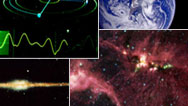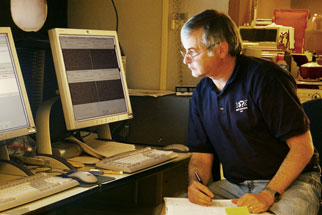Eavesdropping on ET
- By David Levin
- Posted 07.01.08
- NOVA scienceNOW
Seth Shostak, Senior Astronomer at the SETI Institute, thinks it's just a matter of time before we find evidence of other intelligent life in the universe. Learn how he and other astronomers are conducting the search using radio telescopes, and why he thinks there's nothing odd about the endeavor.
Transcript
Eavesdropping on ET
Posted: July 1, 2008
DAVID LEVIN: You're listening to a NOVA podcast. The idea of trying to find aliens with a radio receiver might seem kind of fruitless – or maybe just a little bit weird. But Seth Shostak doesn't think this form of intergalactic eavesdropping is far out, and he's hopeful it might turn up some evidence of intelligent life beyond Earth.
SETH SHOSTAK: It's not odd – it's fully justified by the physics. Even the level of radio technology that we have, only about a hundred years after inventing radio, is good enough to signal to the stars. So if we can do it, presumably, they can do it.
DAVID LEVIN: Shostak is the senior astronomer for SETI, the Search for Extraterrestrial Intelligence. It's an organization that's been trying for over 40 years to find some sort of artificial signal from space. He says we might not comprehend one of these broadcasts if we found it, but it'd be strong sign that we're not alone.
SETH SHOSTAK: Personally I'm not so optimistic that we'll understand it, but to me, that's not so much the point. You could give a copy of a modern day encyclopedia to, you know, Neanderthals, and they'll never understand it, but they would at least know that there's something out there.
DAVID LEVIN: Shostak says that if there is something there, and it's smart enough to have developed advanced technology, there's a decent chance it'll be sending transmissions out all over space. It might not be intentional — they could be stray broadcasts from their version of radio or television, or some sort of radar or GPS system.
SETH SHOSTAK: So that's what's called leakage. If you can pick that up, at least you know there's somebody there that's pretty clever. The first thing is to find that the "on the air" sign for ET is lit.
DAVID LEVIN: We're leaking broadcasts too. Early TV programs like I Love Lucy went on the air more than 50 years ago, and since radio and TV waves move at the speed of light, those transmissions have traveled about 50 light years.
SETH SHOSTAK: And within 50 light years, the number of star systems is on the order of five to ten thousand. So in principle, if any of those nearby five or ten thousand stars have planets with inhabitants with big antenna systems, aimed in our direction, they might be picking up indeed our early television, yeah, could be, could be.
DAVID LEVIN: But that'd be accidental contact with our galactic neighbors. People have been dreaming about deliberately trying to communicate with aliens even before TV or radio was invented.
SETH SHOSTAK: In the 19th century there were even suggested plans to try and signal the Martians, for example, or even people on the Moon, because they assumed there might be some, by flashing lights at them, stuff like that. None of that was done.
DAVID LEVIN: It wasn't until 1960 that the first serious attempt was made. Using a huge antenna in West Virginia, astronomer Frank Drake scanned the cosmos for about two weeks.
SETH SHOSTAK: He pointed it in the direction of a couple of some nearby stars, and he tried to listen for signals. That was the first modern SETI experiment.
DAVID LEVIN: Maybe not surprisingly, Drake turned up empty-handed, but his basic method is still used by SETI today. It's like tuning a standard radio – except instead of listening for top 40, you're listening for an artificial signal from outer space. If you find a signal that's coming in on one narrow slice of the spectrum, Shostak says that something, somewhere, may have planned it that way.
SETH SHOSTAK: Let's, let me show you how that works. Now, we've got a kind of an old time radio here. Let's turn it on—hope the tubes will warm up. [RADIO STATIC] Now, I'll just tune, and you can hear that static. I'll just tune the knob, here, and you hear there's static just about everywhere. That's natural noise. It's noise from the cosmos, from the atmosphere. Now, hear that squeal, now, there you go. [MUSIC] One of my favorite country and western stations. Now you'll notice that signal was at one spot on the dial. That's a deliberate broadcast, and that's what we look for. Not particularly the music, just a lot of energy at one spot.
DAVID LEVIN: Researchers at SETI have been doing a whole lot of waiting so far. It's been nearly 50 years since Frank Drake did his first experiments. But Shostak thinks that doesn't mean much in the long run.
SETH SHOSTAK: Well indeed, we haven't found a signal yet, and people will occasionally ask, are you close? And I don't quite understand that question. How can you know? But what keeps you going is the march of technology means that the experiment gets faster every year. So the chances that you might find something seem to be getting better.
DAVID LEVIN: Actually finding an alien broadcast might be a long shot, but Shostack says that even if there's no guarantee of success, it's still the search that excites him.
SETH SHOSTAK: People seem somewhat surprised that I would do this for a living. To me, that in itself is surprising. Because it seems like kind of a privilege to try and answer a question that you know, every generation has asked. It's very exciting to be able to do that.
Credits
Audio
- Produced by
- David Levin
- Interview by
- Andrea Kissack
Image
- (Seth Shostak)
- © NOVA/WGBH Educational Foundation
Related Links
-

SETI: The Search for ET
Astronomers have their radio telescopes tuned to receive signals from alien worlds. But is anybody out there?
-

The Search for ET: Expert Q&A
Seth Shostak, Senior Astronomer at the SETI Institute and perhaps the funniest man in astrobiology, answers questions.
-

Hunt for Alien Earths
Astronomers may be on the brink of finding Earth-like planets beyond our solar system.
-

The Drake Equation
Try your hand at calculating how many intelligent, communicating civilizations might be in our galaxy.
You need the Flash Player plug-in to view this content.




